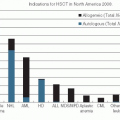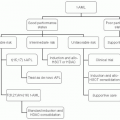Cancer during pregnancy is fairly uncommon. It is the leading cause of death in women of childbearing age with an incidence between 0.07% and 0.1% and approximately 1 in 1,000 pregnancies.
1,2,3 The common malignancies complicating pregnancy include those of the breast, cervix, ovary, leukemia, lymphoma, melanoma, and thyroid
4,5,6,7; however, other cancers have been reported as well. An international study of 215 patients identified between 1998 and 2008 found breast cancer to be the most common at 46%, followed by hematologic malignancies at 18%. The mean maternal age at diagnosis was 33.2 ± 4.8 years, with mean gestational age of 21.0 ± 10.8 weeks.
8A diagnosis of malignancy in a pregnant patient creates a unique dilemma for the mother, her family, and the oncologist. The balance of treating the mother while preventing harmful effects to the fetus is a difficult feat to accomplish. Maternal interest may lie in immediate institution of cancer therapy; however, such therapy may endanger the life of the fetus. A delay or modification of cancer therapy to ensure the birth of a healthy infant could adversely affect maternal prognosis. Substantial harm to the fetus exists whether or not the mother is treated. One study observed an increased risk of small-forgestational-age children (birth 8 [length] <10th percentile) in infants exposed to chemotherapy in utero.
8 Most of these children were born preterm, 54.2%, with a high rate of admissions to the neonatal ICU. Many of these preterm deliveries were medically induced
8 because of the maternal malignancy, 89.7%. This exposes the infants to many early and late complications associated with preterm birth, as well as increased mortality and morbidities later in life such as impaired cognitive and behavioral outcomes. Delay of therapy to allow for fetal maturity may be an option in patients with early-stage disease, especially in those patients with advanced fetal age at the time of diagnosis. In patients with late-stage disease, the option of delaying therapy is much less feasible, posing a significant threat to maternal life.
8,9,10,11 In addition, few chemotherapeutic agents have been tested in pregnant patients, thus the arsenal of drugs available for treatment is limited.
Various ethical, moral, cultural, and religious issues may complicate clinical decision-making. With the increasing trend for women to delay childbearing, the concurrence of cancer and pregnancy may increase in the future, and the progress in both curative cancer chemotherapy and neonatal care will only increase the difficulty of the decision to use chemotherapy.
The adverse effect of pregnancy on the biology of maternal cancer is unclear.
12,13,14,15,16 In breast cancer, two studies reveal that pregnancy is associated with advanced stage at presentation, higher likelihood of receptor-negative tumors, and poorer disease-free and overall survival when compared with stagematched controls.
17,18 Conversely, other studies reveal essentially no difference between the two cohorts of patients.
19,20,21 Because of the relatively rare occurrence and lack of definitive studies, the effects of cancer and the complications of therapy on the fetus are not well-defined. For these reasons, it is best for pregnant cancer patients to be treated in a tertiary setting with access to appropriate gynecologic, oncologic, and neonatal care.
8
PHARMACOKINETICS DURING PREGNANCY
Pregnancy associated physiologic changes may change drug pharmacokinetics and may therefore require altering dosing and schedule of chemotherapy.
Changes in Renal Function and Plasma Volume
The increase in cardiac output and plasma volume increases renal plasma flow and glomerular filtration rate.
22 This increase in renal function results in lowering of serum creatinine concentration.
23 Therefore, pregnancy may amplify the renal excretion of chemotherapeutic agents.
24,25,26,27
Volume Distribution
The increase in total body water,
28 and plasma volume
29 seen in pregnancy, may increase the distribution volume for water-soluble drugs. This may decrease the peak drug concentration, and the half-lives may be prolonged,
30 altering the therapeutic to toxicity ratio of individual chemotherapeutic agents.
31 Furthermore, amniotic fluid as a pharmacologic third space for drugs, such as methotrexate, may delay elimination and increase toxicity.
32
Changes in Plasma Protein Levels
During pregnancy, increased serum levels of certain proteins such as fibrinogen, globulins, and decline of serum albumin levels may affect plasma concentration and distribution of drugs with low lipid solubility and increased affinity for plasma proteins.
33 This may increase the concentration of unbound (active) drugs that can then freely move across different fluid compartments.
Changes in Hepatic Drug Metabolism
Hepatic blood flow and hepatic oxidation are enhanced during pregnancy.
34 Therefore, along with the increased renal excretion
35 there could be increased drug clearance from the body.
Gastrointestinal Absorption
A decrease in gastrointestinal motility could affect the oral drug absorption.
36,37 However, this phenomenon is not changed until late in pregnancy and may be affected by autonomic neuropathy because of vinca alkaloids.
38
Placental Transfer
Several mechanisms govern the movement of drugs across the placenta and the drug levels in placental and fetal circulation. Protein binding appears to be different in maternal and fetal circulation.
33 Moreover, maternal and fetal serum albumin levels may differ at different time periods during pregnancy. Because free drugs cross the placenta more easily, they can achieve higher concentrations in placental and fetal circulation. Other important determinants of drug movement across the placenta are lipid solubility, water solubility, fetal blood pH, and molecular weight of the drug.
30,31,33Except for high-molecular-weight proteins such as asparaginase and interferon
a, most antineoplastic agents possess these properties and easily enter the fetal circulation, where they are subject to the same pharmacokinetic principles. However, the multidrug resistant P-glycoprotein in the gravid endometrium may provide a natural barrier for certain antineoplastic agents, such as vinca alkaloids and the anthracycline antibiotics.
38
Fetal Pharmacokinetics
Fetal liver can metabolize drugs through oxidation, dehydrogenation, reduction, glucuronidation, methylation, and acetylation as early as 7 to 8 weeks of pregnancy.
39 Fetal kidney may also aid in drug elimination, but the extent to which fetal liver and kidney participate in drug elimination is marginal compared with adult liver. If the drugs are excreted into the amniotic fluid, they may be ingested by the fetus and reabsorbed from the gastrointestinal tract, thereby potentially increasing any adverse side effects of drugs such as antimetabolites that are excreted in active form.
Placental Excretion
The placenta is an important route of fetal drug elimination; transplacental passage of antineoplastic agents has been documented with doxorubicin and cisplatin.
40,41,42 In general, because the metabolites are more polar than the parent compound, they may not cross the placenta as easily as the parent compound. As a result, metabolites may accumulate in fetal tissues or amniotic fluid.
33Despite these known maternal, placental, and fetal factors, in the absence of proper pharmacokinetic studies, it is difficult to ascertain the correct dosing of antineoplastic agents in pregnant patients. Therefore, we must assume that drug doses used in the nonpregnant state are adequate in pregnancy.
ADVERSE EFFECTS OF ANTINEOPLASTIC AGENTS ON THE FETUS AND NEONATE
Chemotherapy drugs by damaging rapidly dividing cells could endanger fetal tissues as well and may therefore be associated with deleterious effects. The timing of such exposure is critical in determining the immediate and delayed effect on the embryo and fetus.
Drugs administered in the first week after conception probably produce an “all or nothing” phenomenon—that is, a spontaneous abortion or a normal fetus. During the first trimester of organogenesis, drugs can produce congenital malformations and/or result in an abortion.
43 In the second and third trimesters, the drug may impair fetal growth and development. In particular, neuronal growth in the brain continues during this period and exposure to chemotherapy can produce microcephaly, mental retardation, and impaired learning.
Teratogenicity
The teratogenic and mutagenic effects of chemotherapeutic agents have been well-described in animals,
40,41,42,43,44,45,46 but extrapolation of animal data to human organogenesis is dangerous because of differences in species susceptibility.
47 For instance, many drugs that produce defects in animals appear to be harmless to the human embryo (e.g., aspirin). Conversely, the absence of teratogenicity in animals is no guarantee of safety in humans as observed with thalidomide. More than 2,500 elements have been cataloged as being potentially teratogenic in animal experiments.
48 However, clear evidence of toxicity to the human fetus is available only for a few of these. Risk factors have been assigned to all drugs based on the level of risk a drug poses to the fetus during pregnancy. These risk categories are A, B, C, D, and × as defined by U.S. Food and Drug Administration (FDA)
49 and are shown in
Table 25-1.
Table 25-2 lists some commonly used chemotherapeutic agents, with the pregnancy risk category according to the FDA risk category.
Multiple factors influence the probability of teratogenesis. As noted, the timing of exposure is critical but drug doses, frequency of administration, and duration of exposure are important variables.
50,51,52,53,54,55,56,57 Individual and genetic susceptibility may also be important variables.
44 To be teratogenic, it appears that the dose must lie within a narrow range between that which causes death of the fetus and that which has no discernible effect. Synergistic teratogenic interactions may occur with combination chemotherapy
56,57 or with radiotherapy.
58,59,60Table 25-3 shows data regarding fetal malformations associated with the use of chemotherapy during the first trimester.
61,62,63,64,65,66,67,68 Such data have been extensively reviewed.
61,62,63 In addition, a case report of multiple congenital anomalies associated with the sequential administration of 6-mercaptopurine and busulfan in the first trimester has been described.
58 It is apparent, then, that a number of antineoplastic agents— given alone or in combination—may be teratogenic when administered early in pregnancy. This interpretation should be tempered by the fact that the overall incidence of major congenital malformations is approximately 3% of all births,
69 and the incidence of minor malformations may be as high as 9%. Furthermore, in several reported cases of congenital malformations, the mothers were also treated with radiation,
70,71 which is well-recognized as a potent teratogen in humans and animals.
72






